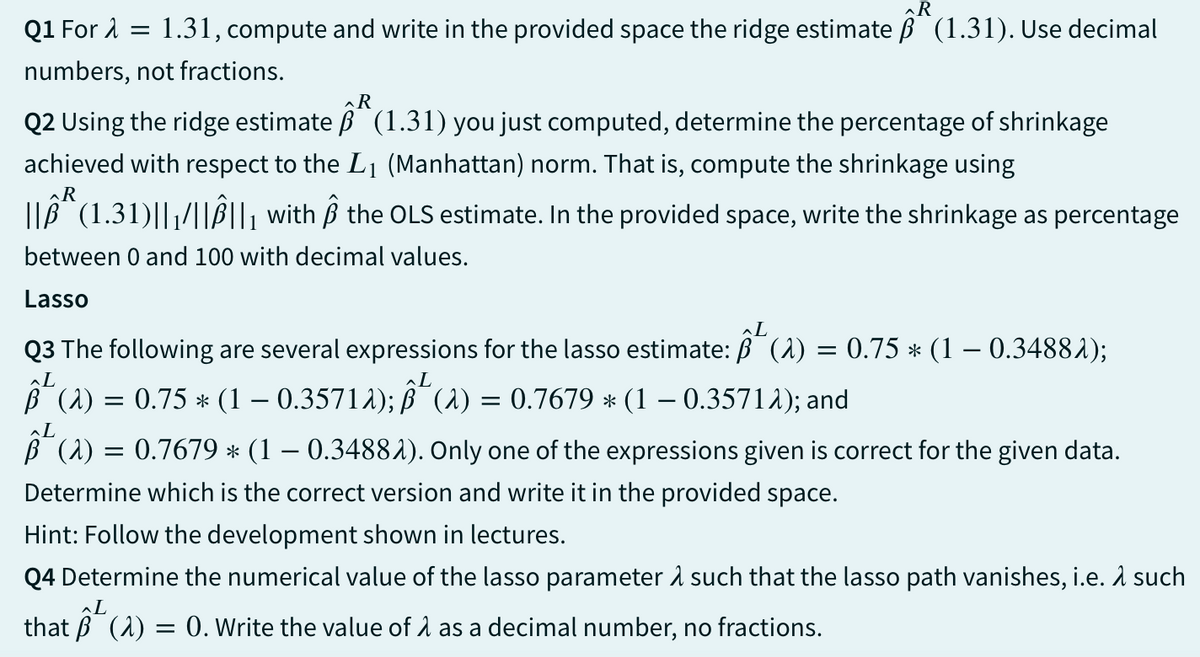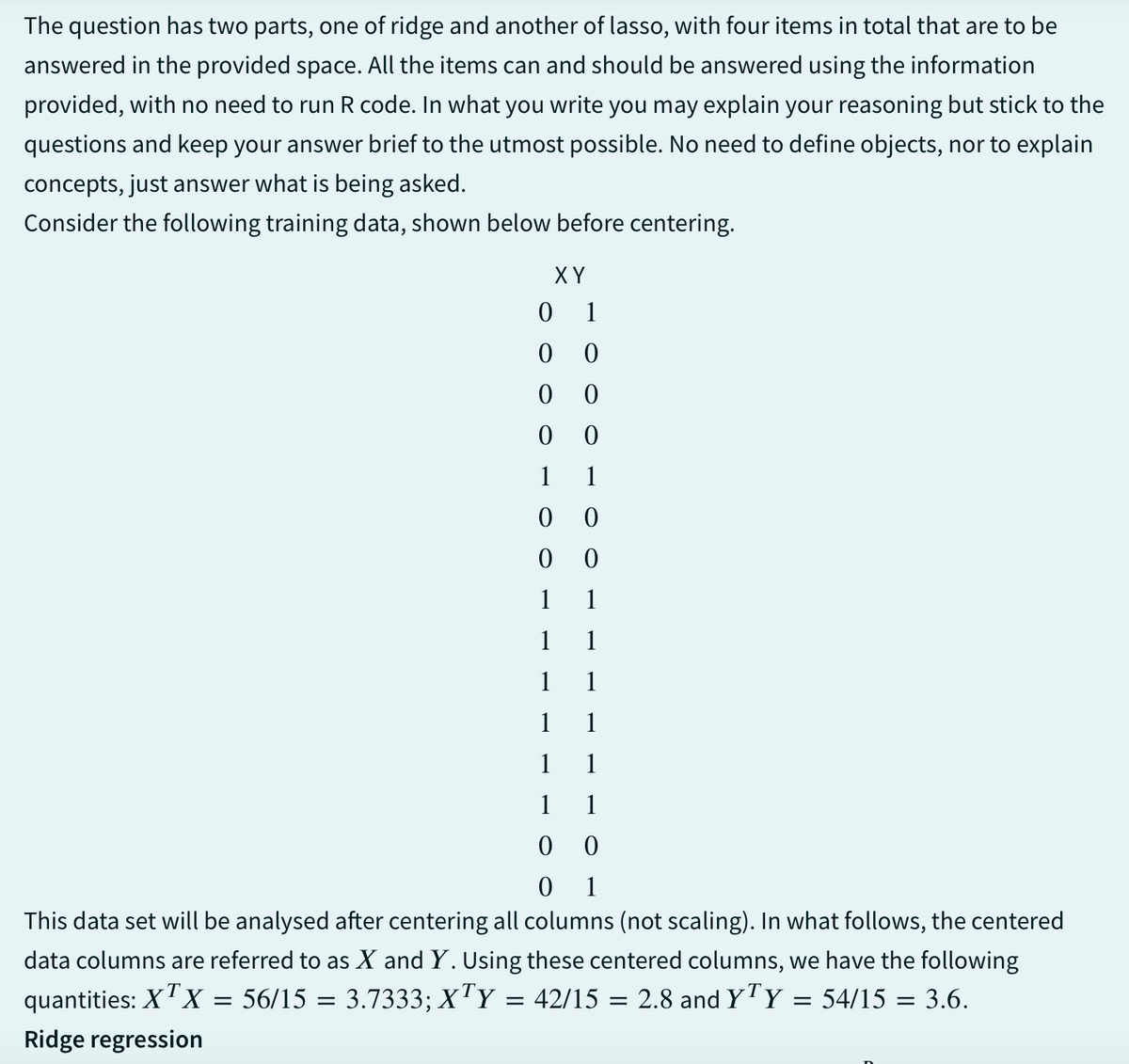R Q1 For λ = 1.31, compute and write in the provided space the ridge estimate ß (1.31). Use decimal numbers, not fractions. R Q2 Using the ridge estimate B (1.31) you just computed, determine the percentage of shrinkage achieved with respect to the L1 (Manhattan) norm. That is, compute the shrinkage using R ||ª (1.31)||1/||B||₁ with ß the OLS estimate. In the provided space, write the shrinkage as percentage between 0 and 100 with decimal values. Lasso L Q3 The following are several expressions for the lasso estimate: B^(2) = 0.75 * (1 − 0.34882); L L B² (a) = 0.75 * (1 − 0.3571λ); ß³ (a) = 0.7679 * (1 − 0.3571λ); and - - (λ) = 0.7679 * (1 − 0.34881). Only one of the expressions given is correct for the given data. Determine which is the correct version and write it in the provided space. Hint: Follow the development shown in lectures. Q4 Determine the numerical value of the lasso parameter & such that the lasso path vanishes, i.e. λ such L that (a) = 0. Write the value of A as a decimal number, no fractions. The question has two parts, one of ridge and another of lasso, with four items in total that are to be answered in the provided space. All the items can and should be answered using the information provided, with no need to run R code. In what you write you may explain your reasoning but stick to the questions and keep your answer brief to the utmost possible. No need to define objects, nor to explain concepts, just answer what is being asked. Consider the following training data, shown below before centering. ΧΥ 0 1 0 0 0 0 0 0 1 1 0 0 0 0 1 1 1 1 1 1 1 1 1 1 1 1 0 0 01 This data set will be analysed after centering all columns (not scaling). In what follows, the centered data columns are referred to as X and Y. Using these centered columns, we have the following quantities: XTX = 56/15 = 3.7333; XTY = 42/15 = 2.8 and YTY Ridge regression = 54/15 = 3.6.
R Q1 For λ = 1.31, compute and write in the provided space the ridge estimate ß (1.31). Use decimal numbers, not fractions. R Q2 Using the ridge estimate B (1.31) you just computed, determine the percentage of shrinkage achieved with respect to the L1 (Manhattan) norm. That is, compute the shrinkage using R ||ª (1.31)||1/||B||₁ with ß the OLS estimate. In the provided space, write the shrinkage as percentage between 0 and 100 with decimal values. Lasso L Q3 The following are several expressions for the lasso estimate: B^(2) = 0.75 * (1 − 0.34882); L L B² (a) = 0.75 * (1 − 0.3571λ); ß³ (a) = 0.7679 * (1 − 0.3571λ); and - - (λ) = 0.7679 * (1 − 0.34881). Only one of the expressions given is correct for the given data. Determine which is the correct version and write it in the provided space. Hint: Follow the development shown in lectures. Q4 Determine the numerical value of the lasso parameter & such that the lasso path vanishes, i.e. λ such L that (a) = 0. Write the value of A as a decimal number, no fractions. The question has two parts, one of ridge and another of lasso, with four items in total that are to be answered in the provided space. All the items can and should be answered using the information provided, with no need to run R code. In what you write you may explain your reasoning but stick to the questions and keep your answer brief to the utmost possible. No need to define objects, nor to explain concepts, just answer what is being asked. Consider the following training data, shown below before centering. ΧΥ 0 1 0 0 0 0 0 0 1 1 0 0 0 0 1 1 1 1 1 1 1 1 1 1 1 1 0 0 01 This data set will be analysed after centering all columns (not scaling). In what follows, the centered data columns are referred to as X and Y. Using these centered columns, we have the following quantities: XTX = 56/15 = 3.7333; XTY = 42/15 = 2.8 and YTY Ridge regression = 54/15 = 3.6.
Related questions
Question

Transcribed Image Text:R
Q1 For λ = 1.31, compute and write in the provided space the ridge estimate ß (1.31). Use decimal
numbers, not fractions.
R
Q2 Using the ridge estimate B (1.31) you just computed, determine the percentage of shrinkage
achieved with respect to the L1 (Manhattan) norm. That is, compute the shrinkage using
R
||ª (1.31)||1/||B||₁ with ß the OLS estimate. In the provided space, write the shrinkage as percentage
between 0 and 100 with decimal values.
Lasso
L
Q3 The following are several expressions for the lasso estimate: B^(2) = 0.75 * (1 − 0.34882);
L
L
B² (a) = 0.75 * (1 − 0.3571λ); ß³ (a) = 0.7679 * (1 − 0.3571λ); and
-
-
(λ) = 0.7679 * (1 − 0.34881). Only one of the expressions given is correct for the given data.
Determine which is the correct version and write it in the provided space.
Hint: Follow the development shown in lectures.
Q4 Determine the numerical value of the lasso parameter & such that the lasso path vanishes, i.e. λ such
L
that (a) = 0. Write the value of A as a decimal number, no fractions.

Transcribed Image Text:The question has two parts, one of ridge and another of lasso, with four items in total that are to be
answered in the provided space. All the items can and should be answered using the information
provided, with no need to run R code. In what you write you may explain your reasoning but stick to the
questions and keep your answer brief to the utmost possible. No need to define objects, nor to explain
concepts, just answer what is being asked.
Consider the following training data, shown below before centering.
ΧΥ
0 1
0
0
0
0
0
0
1
1
0
0
0
0
1
1
1
1
1
1
1
1
1
1
1 1
0
0
01
This data set will be analysed after centering all columns (not scaling). In what follows, the centered
data columns are referred to as X and Y. Using these centered columns, we have the following
quantities: XTX
= 56/15 = 3.7333; XTY = 42/15 = 2.8 and YTY
Ridge regression
= 54/15 = 3.6.
Expert Solution
This question has been solved!
Explore an expertly crafted, step-by-step solution for a thorough understanding of key concepts.
Step by step
Solved in 2 steps
